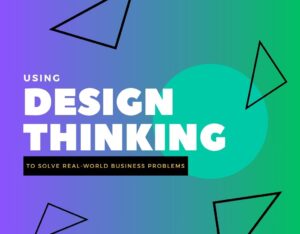
In today’s dynamic business landscape, companies are faced with complex challenges that demand creative and innovative solutions. For MBA aspirants looking to excel in leadership roles, Design Thinking offers a powerful framework to tackle these real-world problems and drive meaningful impact. Business schools and organizations around the globe are increasingly adopting Design Thinking to foster innovation, develop customer-centric strategies, and solve ambiguous challenges.
What is Design Thinking?
Design Thinking is a human-centered problem-solving approach that focuses on understanding user needs, challenging assumptions, and developing innovative solutions. It is particularly effective for solving complex problems where traditional, linear methods fall short. The process emphasizes five key stages:
- Empathize: Understand the user and their pain points.
- Define: Clearly articulate the problem you are solving.
- Ideate: Generate a wide range of creative ideas.
- Prototype: Develop simple, low-cost solutions.
- Test: Gather feedback, refine, and iterate.
Why Design Thinking is Essential for MBA Aspirants
- Problem-Solving at Scale: Businesses today face challenges such as digital disruption, customer retention, and sustainability. Design Thinking equips future leaders with tools to tackle these challenges creatively.
- Human-Centered Leadership: MBA graduates are expected to lead teams and organizations. Design Thinking emphasizes empathy, helping leaders understand people—customers, employees, and stakeholders—to make informed decisions.
- Competitive Edge in the Job Market: Employers increasingly value creative problem-solving abilities. According to the World Economic Forum, creativity and complex problem-solving are among the top skills for future jobs.
- Driving Innovation: Whether launching a startup or innovating within a company, MBA students who embrace Design Thinking can lead transformative projects.
- Learning by Doing: Design Thinking emphasizes action. For MBA aspirants, it is an opportunity to combine theory with practical learning.
Real-Life Examples of Design Thinking Success
- Airbnb: A Startup Transformed with Design Thinking
Before becoming a global success, Airbnb faced significant challenges—low bookings and a lack of trust among customers. By applying Design Thinking, the company focused on the user experience:
- Empathize: The team identified poor-quality photos as a major hurdle for customers.
- Define: Trust and presentation were key problems to solve.
- Prototype & Test: They visited hosts, took professional photos, and improved listings.
This simple yet effective approach led to 2x higher bookings, setting Airbnb on a path to success. Airbnb demonstrates how Design Thinking can transform startups into industry disruptors.
- PepsiCo: Innovating Healthier Products
Under Indra Nooyi’s leadership, PepsiCo used Design Thinking to adapt to consumer demands for healthier options. By understanding customer needs and emphasizing innovation, PepsiCo introduced products like Baked Lay’s and Quaker Oats.
Results: A 10% increase in revenue from healthier products and stronger customer loyalty.
- IBM: A Culture of Design Thinking
IBM has embedded Design Thinking into its operations to foster innovation and enhance customer experiences. By introducing IBM Enterprise Design Thinking, the company enabled teams to:
- Solve client problems faster.
- Increase collaboration across teams.
IBM reported a 301% ROI from its design efforts, with faster project delivery and better client satisfaction. This example highlights how Design Thinking transforms organizational culture and creates value for customers.
How MBA Programs Are Teaching Design Thinking
Leading business schools have recognized the importance of Design Thinking and are integrating it into their curricula. For MBA aspirants, this is an opportunity to gain hands-on experience and develop critical skills. Programs include:
- Design Thinking Workshops: Immersive sessions where students solve real business challenges.
- Innovation Labs and Incubators: Platforms to prototype and test business ideas.
- Case Studies and Simulations: Learning from companies like Airbnb, PepsiCo, and IBM.
- Collaborative Projects: Working with peers from diverse backgrounds to generate innovative solutions.
These experiences help students develop an entrepreneurial mindset, enhance creativity, and learn to lead in uncertain environments—all essential skills for future managers and business leaders.
Key Benefits for MBA Aspirants
- Enhanced Creativity and Problem-Solving: Learn to tackle challenges with out-of-the-box thinking.
- Improved Leadership Skills: Empathize with stakeholders and lead teams to success.
- Higher Employability: Gain skills that are in high demand among top employers.
- Adaptability: Design Thinking fosters agility, a must-have for navigating changing markets.
- Practical Learning: Apply classroom concepts to solve real-world business challenges.
Concluding remarks
For MBA aspirants, Design Thinking offers a unique and practical approach to addressing today’s business challenges. Whether you aim to innovate within a Fortune 500 company, launch a startup, or lead strategic projects, mastering Design Thinking will give you a significant edge.
The ability to empathize with customers, generate creative solutions, and iterate quickly sets MBA graduates apart as future-ready leaders. As more businesses embrace Design Thinking to drive growth, aspiring professionals who develop this skill will be in high demand.
If you’re considering an MBA, look for programs that integrate Design Thinking into their curriculum. It’s more than a problem-solving tool—it’s a mindset that will empower you to lead, innovate, and create a lasting impact in the business world.





